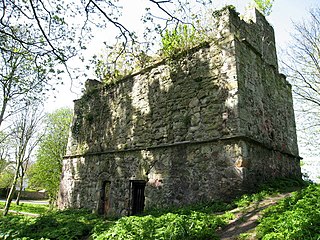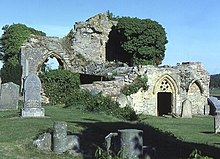
Dryburgh Abbey, near Dryburgh on the banks of the River Tweed in the Scottish Borders, was nominally founded on 10 November (Martinmas) 1150 in an agreement between Hugh de Morville, Constable of Scotland, and the Premonstratensian canons regular from Alnwick Abbey in Northumberland. The arrival of the canons along with their first abbot, Roger, took place on 13 December 1152.

Donnchadh was a Gall-Gaidhil prince and Scottish magnate in what is now south-western Scotland, whose career stretched from the last quarter of the 12th century until his death in 1250. His father, Gille-Brighde of Galloway, and his uncle, Uhtred of Galloway, were the two rival sons of Fergus, Prince or Lord of Galloway. As a result of Gille-Brighde's conflict with Uhtred and the Scottish monarch William the Lion, Donnchadh became a hostage of King Henry II of England. He probably remained in England for almost a decade before returning north on the death of his father. Although denied succession to all the lands of Galloway, he was granted lordship over Carrick in the north.

The Abbot and then Commendator of Melrose was the head of the monastic community of Melrose Abbey, in Melrose in the Borders region of Scotland. The abbots of the earlier Northumbrian foundation from Lindisfarne are not included here. The second abbey was founded in 1136 on the patronage of David I, King of Scots, by Cistercian monks from Rievaulx Abbey, Yorkshire. Control of the abbey was secularized in the 16th century and after the accession of James Stewart, the abbey was held by commendators. The last commendator, James Douglas of Lochleven, resigned the abbacy to William Douglas, 6th Earl of Morton in December 1606, and the abbey itself to the king in 1608. The abbey was then erected into a secular lordship for viscount Haddington, John Ramsay, who in 1609 was created "Lord Melrose". Lochleven however resumed the title of commendator in 1613 until his death in 1620.

Jocelin was a twelfth-century Cistercian monk and cleric who became the fourth Abbot of Melrose before becoming Bishop of Glasgow, Scotland. He was probably born in the 1130s, and in his teenage years became a monk of Melrose Abbey. He rose in the service of Abbot Waltheof, and by the time of the short abbacy of Waltheof's successor Abbot William, Jocelin had become prior. Then in 1170 Jocelin himself became abbot, a position he held for four years. Jocelin was responsible for promoting the cult of the emerging Saint Waltheof, and in this had the support of Enguerrand, Bishop of Glasgow.
The Abbot of Balmerino was the head of the Cistercian monastic community and lands of Balmerino Abbey, Fife, founded in 1227 x 1229 by monks from Melrose Abbey with the patronage of Ermengarde de Beaumont and King Alexander II of Scotland. The following are a list of abbots and commendators.
The Abbot of Kinloss was the head of the property and Cistercian monastic community of Kinloss Abbey, Moray, founded by King David I of Scotland around 1151 by monks from Melrose Abbey. The abbey was transformed into a temporal lordship for Edward Bruce, the last commendator, who became Lord Kinloss. The following is a list of abbots and commendators:
The Abbot of Deer, was the head of the Cistercian monastic community of Deer Abbey in Buchan. It was founded in 1219 by William Comyn, jure uxoris Earl of Buchan. There was an earlier community of Scottish monks or priests which was probably absorbed by the new foundation. It was turned into a secular lordship for Commendator Robert Keith II in 1587. The following is a list of known abbots and commendators:
The Abbot of Newbattle was the head of the Cistercian monastic community of Newbattle Abbey, Midlothian. It was founded by David I of Scotland in 1140.
Clement was a 13th-century Dominican friar who was the first member of the Dominican Order in Britain and Ireland to become a bishop. In 1233, he was selected to lead the ailing diocese of Dunblane in Scotland, and faced a struggle to bring the bishopric of Dunblane to financial viability. This involved many negotiations with the powerful religious institutions and secular authorities which had acquired control of the revenue that would normally have been the entitlement of Clement's bishopric. The negotiations proved difficult, forcing Clement to visit the papal court in Rome. While not achieving all of his aims, Clement succeeded in saving the bishopric from relocation to Inchaffray Abbey. He also regained enough revenue to begin work on the new Dunblane Cathedral.
Robert de Keldeleth was a 13th-century Benedictine and then Cistercian abbot. He started his senior career as Abbot of Dunfermline (1240–52), becoming Chancellor of Scotland later in the 1240s. He took a prominent role as a supporter of Alan Durward during the minority of Alexander III of Scotland, and appears to have lost the Chancellorship as result. Following his resignation of the abbacy of Dunfermline, he became a Cistercian monk at Newbattle Abbey while continuing a comparatively less active role on the wider stage. In 1269 he became Abbot of Melrose (1269–1273), Newbattle's mother house, and held this position for the last four years of his life.

Henry was a 13th-century Augustinian abbot and bishop, most notable for holding the positions of Abbot of Holyrood and Bishop of Galloway.

Gilbert was a 13th-century Cistercian monk, abbot and bishop. His first appearance in the sources occurs under the year 1233, for which year the Chronicle of Melrose reported that "Sir Gilbert, the abbot of Glenluce, resigned his office, in the chapter of Melrose; and there he made his profession". It is not clear why Gilbert really did resign the position of Abbot of Glenluce, head of Glenluce Abbey in Galloway, in order to become a mere brother at Melrose Abbey; nor is it clear for how long Gilbert had been abbot, though his latest known predecessor is attested last on 27 May 1222. After going to there, Gilbert became the Master of the Novices at Melrose.
Odo Ydonc was a 13th-century Premonstratensian prelate. The first recorded appearance of Odo was when he witnessed a charter by Donnchadh, Earl of Carrick, on 21 July 1225. In this document he is already Abbot of Dercongal, incidentally the first Abbot of Dercongal to appear on record.
Reinald Macer [also called Reginald] was a medieval Cistercian monk and bishop, active in the Kingdom of Scotland during the reign of William the Lion. Originally a monk of Melrose Abbey, he rose to become Bishop of Ross in 1195, and held this position until his death in 1213. He is given the nickname Macer in Roger of Howden's Chronica, a French word that meant "skinny".
Jonathan was a churchman and prelate active in late twelfth- and early thirteenth century Strathearn, in the Kingdom of Scotland. He was the Bishop of Dunblane during the time of Gille Brigte of Strathearn, and it was during Jonathan's episcopate that Gille Brigte founded an Augustinian priory at Inchaffray.
Bernard was a Tironensian abbot, administrator and bishop active in late 13th- and early 14th-century Scotland, during the First War of Scottish Independence. He first appears in the records already established as Abbot of Kilwinning in 1296, disappearing for a decade before re-emerging as Chancellor of Scotland then Abbot of Arbroath.

Robert I or Robert of Nostell was a 12th-century Anglo-Norman Augustinian churchman, the first prior of St Andrews.

St. Mary's Priory, North Berwick, was a monastery of nuns in medieval East Lothian, Scotland. Founded by Donnchad I, Earl of Fife around 1150, the priory lasted for more than four centuries, declining and disappearing after the Scottish Reformation. It had been endowed by the Earls of Carrick as well as the Earls of Fife, but over time lost its dependence on these and came to be controlled by the more locally based Home family, who eventually acquired the priory's lands as a free barony.
Walter I was a 12th-century Augustinian Anglo-Norman prelate active in the kingdom of Scotland.
Thomas was an Augustinian canon and Cistercian monk in 13th-century Scotland. According to Walter Bower Thomas was sub-prior of St Andrews Cathedral Priory when he became prior of St Andrews, sometime in 1199. He appears as prior in contemporary documents for the first time on 6 June 1199.







